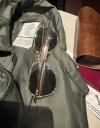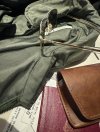Skyhawk
Well-Known Member
This is a very interesting and iconic piece of aviation gear. Aviator sunglasses have been with us since 1935 and like many pieces of WWII era aviation gear, have become an enduring and iconic symbol of style and adventure. They have run rampant in the fashion and film industry for decades.
This thread seeks to explore the origins, the modifications, the military specifications, and the manufacturers of these forever "Cool" pieces of military aviation history.
I am not an expert but this is what an initial search has turned up. Let's go on this journey of exploration together!
1. 1935 The USAAC commissioned the American Optical Company to produce the first aviator sunglasses. This established the metal frame and crossbar style. It appears that the first design had the teardrop shaped lens
2. Like many things, these glasses soared in popularity during WWII when photos started showing aircrews and generals wearing them.
3. The prolific military contractor Bausch & Lomb seized upon this opportunity and created the name RAY BAN to market these glasses to the general public.
3. AO continued to make military glasses up until 1972. There appears to have been several Mfg's.
4. In 1972, Randolph Engineering Company took over the military contract and they are the supplier of issued military aviator sunglasses to this day.
5. Military designation - HGU-4/P
6. Military Specification - MIL-S-25948


This thread seeks to explore the origins, the modifications, the military specifications, and the manufacturers of these forever "Cool" pieces of military aviation history.
I am not an expert but this is what an initial search has turned up. Let's go on this journey of exploration together!
1. 1935 The USAAC commissioned the American Optical Company to produce the first aviator sunglasses. This established the metal frame and crossbar style. It appears that the first design had the teardrop shaped lens
2. Like many things, these glasses soared in popularity during WWII when photos started showing aircrews and generals wearing them.
3. The prolific military contractor Bausch & Lomb seized upon this opportunity and created the name RAY BAN to market these glasses to the general public.
3. AO continued to make military glasses up until 1972. There appears to have been several Mfg's.
4. In 1972, Randolph Engineering Company took over the military contract and they are the supplier of issued military aviator sunglasses to this day.
5. Military designation - HGU-4/P
6. Military Specification - MIL-S-25948
Last edited:



